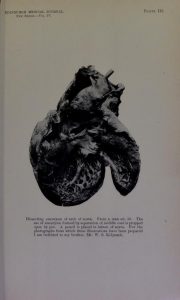 Please join us for the next in the series of Bullitt History of Medicine Club Lectures on Tuesday, November 8, 2016, 12:00 noon in the UNC Health Sciences Library, Room 527. Refreshments provided! Our speaker will be Justin Barr, MD, PhD, General Surgery Residency Program, Duke University Medical Center. Justin is a resident in the Department of Surgery at Duke University Medical Center, with clinical interests in vascular and transplant surgery and research interests in the history of surgery and military medical history. He has a BA in History from the University of Washington in St. Louis, a PhD in History from Yale University, and an MD from the University of Virginia. His honors and awards include the AppleSeed Award for excellence in educating medical students (Duke University, 2015-2016), and the Edwin W. Small Prize for best dissertation in American History (Yale University, 2015).
Please join us for the next in the series of Bullitt History of Medicine Club Lectures on Tuesday, November 8, 2016, 12:00 noon in the UNC Health Sciences Library, Room 527. Refreshments provided! Our speaker will be Justin Barr, MD, PhD, General Surgery Residency Program, Duke University Medical Center. Justin is a resident in the Department of Surgery at Duke University Medical Center, with clinical interests in vascular and transplant surgery and research interests in the history of surgery and military medical history. He has a BA in History from the University of Washington in St. Louis, a PhD in History from Yale University, and an MD from the University of Virginia. His honors and awards include the AppleSeed Award for excellence in educating medical students (Duke University, 2015-2016), and the Edwin W. Small Prize for best dissertation in American History (Yale University, 2015).
Aortic aneurysms – or balloon-like dilations of the largest blood vessel in the body – represent an acute threat to the life of a patient, a threat that physicians have recognized and struggled to treat for centuries. With aneurysms an identifiable pathology whose rupture is both unpredictable and fatal, they commanded disproportionate attention in the medical literature. This paper explores the development of interventions physicians and surgeons have deployed to treat this disease. Viewed over time, aortic aneurysms become a sampling device for revealing how shifting therapeutic strategies sought to harness broader transformations in physiological knowledge, technological innovation, and surgical technique to manage one specific problem.
Treatment of aortic aneurysms began in the 18th century. Applying recent research on circulation and blood coagulation to the problem, leading physicians like René Laennec and Antonio Valsalva devised whole-body fasting and bleeding regimens to prevent rupture. Surgeons, following John Hunter’s success in ligating arteries for peripheral aneurysms, attempted analogous operations on the aorta, but even leading surgeons like Astley Cooper and William Halsted met with disastrous results. Others tried various methods of creating intra-luminal clots, including applying new technologies like electricity and plastic. Vessel repair techniques, developed by Alexis Carrel and others in the 20th century, eventually provided a reliably effective treatment. In the last couple of decades, the field has adopted to the minimally invasive approaches that increasingly define surgery and developed endovascular operations through small groin incisions. The successful 2005 Congressional campaign to fund screening for aortic aneurysms brought the disease national attention – and highlights current confidence in curing the condition.
Ignored in the historical literature, this topic receives only superficial coverage in surgical journals. Drawing on a wide variety of published and unpublished sources, this talk not only elucidates the development of specific treatments for aortic aneurysms but also more broadly addresses how medicine and surgery apply the knowledge and technology available in particular eras to treat a specific, identifiable, and lethal disease.
~This post is courtesy Dawne Lucas, Special Collections Librarian.





